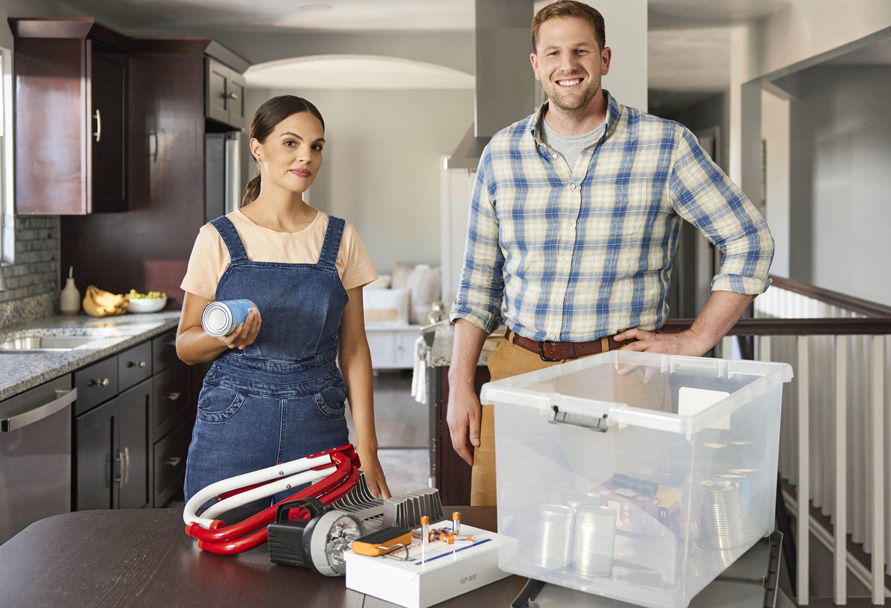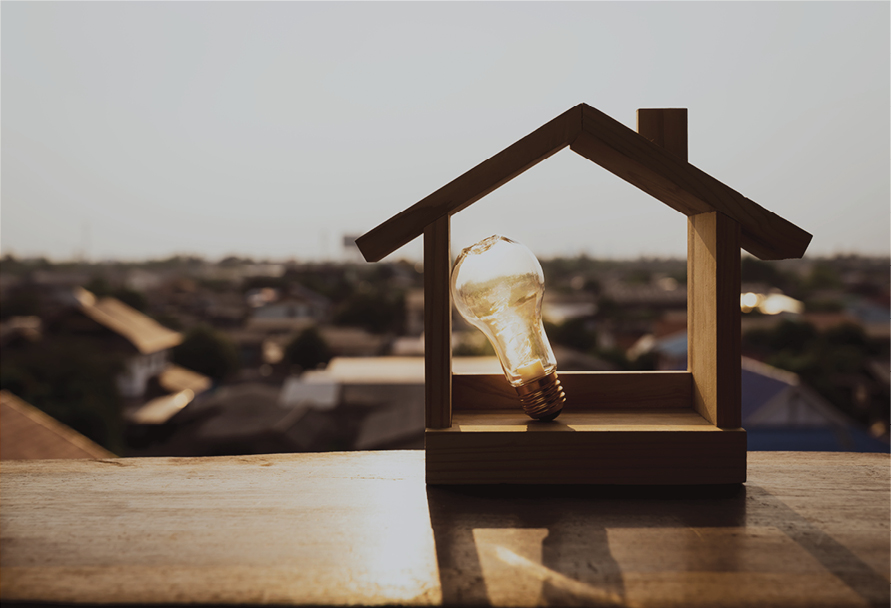Fall and winter energy-saving tips
Take time to prepare your home for the cold weather. By reducing your energy usage, you can keep your bills lower and take steps to a more energy-efficient lifestyle. Here are some simple ways to be more mindful of your energy usage.
Home maintenance tips to save energy
Heating
Furnace
- Replace the filter. Dirty filters make your furnace run much harder and circulate dirty air through your house. You should be able to see light clearly through the filter. If not, it needs to be changed. Clean your furnace filter monthly, and follow any other routine maintenance procedures described in the owner's manual.
- Move away clutter. Sometimes, when our furnace hasn’t run in a few months, we inadvertently store things around it. This is especially dangerous if the stored items are flammable. Make sure to clear away the space around your furnace. While you’re at it, check vents in your home and make sure nothing is blocking them.
- Get a furnace inspection. Your furnace will be hard at work once the cold arrives. Make sure it’s in peak condition with an inspection from one of our experienced techs. An efficiently operating furnace will save you in energy costs. Consider signing up for a Service Guard plan for extra peace of mind. With Service Guard, a broken appliance isn’t an emergency.
Fireplaces
- Check the damper. If you have a fireplace, make sure your damper closes tightly when you're not using it. Closing the damper could save 8 percent of your home's heat. An open or poorly fitted damper will allow the warm air from your home to escape out the chimney.
- Ensure it has proper ventilation. If it's not properly designed, a fireplace can pull cold air into the building along the floor and make the room cold. Many newer fireplaces are made with vents to provide fresh cool air and give off warmed air. Glass panels on the fireplace can be effective.
- Do a safety check. Put your wood-burning appliance safely away from walls, and make sure the chimney is installed according to safety guidelines. You should also make sure your chimney is clean and that a qualified contractor inspects it annually.
Thermostat
- Turn down the heat. You can save as much as 10 percent a year on your heating bill by simply turning your thermostat back 10 percent to 15 percent for eight hours. You can do this automatically without sacrificing comfort by installing an automatic setback thermostat (also known as a clock or programmable thermostat). You can set this type of thermostat to automatically turn down or up during certain times of the day. Check with your heating contractor or local hardware store for costs involved in the installation of programmable thermostats.
- A good rule of thumb is to set the temperature as low as you can and still be comfortable. Each degree you lower your heat in the 60-70 degree range will save 2 percent on your heating costs. The ideal temperature would be around 68 degrees.
- Move thermostat away from heat source. Locate your thermostat on an inside wall where it won't be affected by the sun or a heat source.
- You can also save energy and money by installing a demand controller. (Available in South Dakota only.)
Weatherization
Insulation
- Insulate exterior walls. Proper insulation keeps your home warm in winter and cool in summer. In fact, you can lose as much as 20 percent of your heating energy through an un-insulated ceiling. Read some helpful tips on insulating your home.
- Check the duct work. Most ducts are in unheated spaces and are a common source of heat loss. Get more information on insulation.
Windows and doors
- Replace old windows. If you have an older home or office, consider replacing older windows that allow air drafts. If that's too expensive, consider initially replacing the draftiest windows first.
- Install glass storm doors.
- Caulk and seal any openings. Prevent heat loss by caulking and weather-stripping doors and windows.
- Let the sun in. Take down any awnings over your windows to let in winter sunshine. Close your drapes on cold days and at night but open them during the daytime. This will help the sun heat your home.
Appliances
Ovens and stoves
- Check foods through the oven window. You may lose 25 to 50 degrees Fahrenheit each time you open the door.
- Turn off the oven a few minutes before cooking time ends. For many dishes, especially those that require a long cooking time, you can turn off the oven a few minutes before finishing. The oven will remain hot enough to complete the job.
- The self-cleaning feature is expensive. Learn to wipe up promptly after baking or roasting to avoid using the self-cleaning feature. A "continuous cleaning" oven doesn't use extra energy.
- Put a shine on your reflector pans. Dirty, dull pans absorb heat instead of reflecting it.
- Match the pan to the surface burner. A pan that fits the burner cooks better.
- Thaw food before cooking it. It’s wasteful to thaw food by cooking it, and it won’t cook as well.
- Use smaller cooking appliances when possible.
Water heater
- Take a shower instead of a bath. Typically, a shower uses 10-20 gallons of water, while a bath uses 30. But don't shower for more than five minutes.
- Fix that leaky faucet. One drop of water per second equals 60 gallons of water a week. A leak that would fill a coffee cup in 10 minutes would waste 3,280 gallons of water in a year.
- Use cold water when you can. Modern detergents allow you to use cold water more than ever before. Eighty to 85 percent of the energy used in washing clothes is from heating the water.
- Install flow restrictors and aerators. By installing water flow restrictors in shower heads and faucets, you could save up to 50 percent on hot water use. There are different types of flow restrictors for shower heads and aerators for other faucets. They all reduce water usage without being noticeable.
- Lower your water heater setting. Lowering your temperature setting a few degrees can save energy. Lowering your temperature to under 120 degrees can save you up to 10 percent on your water heater costs.
- On-demand water heaters. For on-demand water heaters, ensure there isn't hardwater build up on the heating elements
Washers and dryers
- Don't use an entire wash cycle for only a couple of garments. On the other hand, jamming too much into a wash load causes extra wrinkles and lint.
- Always clean the lint trap after each use, or before you start a new load. Also, double-check the pockets of your garments.
- Keep it clean. Maintain dryer vents and clean underneath and behind the dryer regularly.
- Plan your drying cycle. First dry larger, bulkier clothes, and then use a shorter cycle for small, light garments.
- Don't go overboard on suds. Too much detergent may hurt your clothes and your washing machine. Use cold or lukewarm water when you can. You'll save with every load when you use cooler water. And cold water helps reduce lint.
- Address maintenance issues promptly. If dryers are taking longer than usual, it can contribute significantly to your electric usage.
Lighting
Save energy with your lights
- Use a dimmer or three-way switch. Oftentimes our lighting needs depend on whatever activity we’re doing at the time. Installing dimmer switches or using three-way bulbs will let you select the right amount of light for each activity.
- Be an "enlightened" decorator. Decorate your home or business with illumination in mind. Light colors reflect light, so use them in areas you want to be bright.
- Keep lighting fixtures clean. A cleaner bulb is a brighter bulb. But let incandescent bulbs cool before cleaning or they may break.
- Use natural light when possible.
- Use LED lightbulbs. LED bulbs use about 20-25 percent of the energy in your home, and lasts up to 25 times longer than traditional incandescent bulbs.
- Install motion detectors or timer switches. In low-trafficked areas like outdoor areas, basements or garages, it is easy for a light to be left on for days. By installing motion detectors or timer switches, you can make sure you're not lighting an area when it’s unnecessary.
Holiday lights
Holiday lighting can add up on your November and December household power bill. But you can have a festive display for much less. Here are some things to think about as you plan your holiday decorations.
- LED lights: LEDs are less expensive to operate and work well outdoors because of their durability and performance in cold environments.
- Bulb wattage: The large, traditional bulbs (may be labeled C-7 or C-9) use four to 10 watts per bulb. Mini-lights use about four tenths of a watt per bulb, and the new LED lights use only four one-hundredths of a watt. The lower wattage the bulb, the less energy it is using.
- Bulbs per string: The larger bulbs are usually sold 25 to a string, while the smaller bulb sets may have 35 to 200 bulbs per string. Icicle lights have 100 lights per 10-foot string. LED lights have 35-100 bulbs per string.
- Strings per house: The more lights you use, the more power you'll use. But whether you use only one light string or many, you'll be rewarded with a lower power bill if you use energy-efficient lights.
- Timing is everything: You can reduce your energy use by running your outdoor lights on a timer pre-set for three to five hours and by using mirrors and tinsel around indoor lights to increase the lighting effects.
Living habits
By changing a few habits and monitoring your usage more closely, you'll find creating an energy efficient home is easier than you think.
- Dress warmly in your home. Wearing sweaters or other warm clothes at home can really help. Loose-fitting clothes are comfortable, and they help hold in your body heat naturally.
- Use ventilating fans only as needed. Use kitchen, bath and other ventilating fans sparingly. In just one hour, these fans can blow away a house full of warmed air. Turn them off just as soon as they have done their job.
- Move furniture away from the air registers. This allows for free flow of heated air.
- Not using it? Unplug it. Unplug office equipment like printers, shredders, scanners, and other household appliances, like your coffee maker, to prevent them from pulling energy when not in use.



